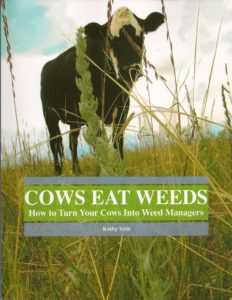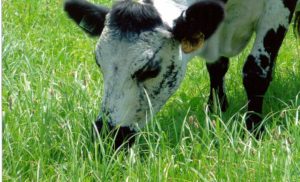Yes, Cows Eat Weeds!
Learn from Kathy Voth’s work
The Northeast Pasture Consortium (NEPC) Annual Meeting was held in January this year inVermont. The weather can be questionable at best in January, but it cooperated this year. The latest pasture research was presented by universities, agencies and producers at the two-day conference. Many great projects were shared and lots of time for networking was allotted.

Kathy Voth explains in her book that weeds are high in protein when vegetative. Image provided by Kathy Voth
One very practical session with great on-farm potential was brush and weed control on pastures. Research on finding biological controls of multiflora rose was covered as well as getting cattle to clear idle pastures. The speaker that I was most excited about was Kathy Voth from “Livestock for Landscapes” in Loveland, Colorado. She presented her research on training cows to eat weeds.
Kathy’s work on this began in earnest in 2004. Prior to that, she had been sitting in on classes and reading Dr. Fred Provenza’s work atUtahStateUniversityin animal behavior. She presented some of her work at the Northeast Grasstravaganza in Binghamton in 2008. Since then, she has continued to teach cattle this concept in the west and across the country.
Disclaimer: When I refer to livestock, I am referring to ruminant livestock. That does not include horses!
The biggest hurdle with the concept of four-legged weed control is sometimes the human mindset. A weed is any plant out of its proper place. That does not denote poor nutritive value. Kathy has run forage analyses on weed specimens and they tend to be high in protein when vegetative.
So, here are the basics:
Step 1: Know your weed
Make sure you know what weed you are training your livestock to eat. Weeds (and plants) have toxins in them; some weeds are poisonous. Don’t train your livestock to eat poisonous weeds! Begin by researching what toxin is in the weed. Cornell’s Department of Animal Science has a basic web site: http://www.ansci.cornell.edu/plants/ This will provide you Latin and common names and the toxin and species affected. Other web sites are out there as well. Kathy strongly suggests getting your hands on “A Guide to Plant Poisoning of Animals inNorth America”, by Anthony P. Knight and Richard Walter. I have this book and it provides complete descriptions of the toxins present in weeds you may target. It has a hefty price tag, but worth the price in the long run.
Focus on one weed for training purposes. Later, when out in the pasture, the cattle will be more apt to try other weeds.
Cattle will pay attention to “post-ingestive feedback”. They eat a weed and the brain registers how they feel. If it’s not good, they won’t eat what made them ill. If it makes them feel good, they will eat it again. Also, toxin levels can change throughout the growing season. This is not a failsafe system, so that’s why you need to know your weed.
Step 2: Choose your trainees and training location

Your practice pasture should include a patch of the target weed plus some others as well as their “good” pasture.
It is best to train a manageable number of young females; they are more apt to try new things since they don’t know any better! Once they are trained, they can later train their offspring and herd mates. If you don’t have heifers to train, work with cow-calf pairs. It’s also best to work with tame cattle. They need to know you and trust you since you are the one that will be doing the training.
If your cattle are used to coming to you, training can occur in a pasture. This makes it simpler by having water and feed already there. They can also be training in a barnyard enclosure, but they will need feed and water there. One thing for sure, they need a familiar area to reduce stress; they will be more apt to try something new.
Step 3: Make the unfamiliar seem familiar
Now we are getting down to the details of the training. Kathy has developed a training process that occurs over 10 days, depending on if your cattle are fast or slow learners.
Begin by purchasing 8 different kinds of feed with one of those being something they are familiar with. This will not be their sole food supply, just a treat. Kathy uses 50 pounds per 25 “trainees” per feeding. Place the feed in tubs shared by the cattle. This increases competition among the cattle to clean up the feed.
- Day one begins with the familiar feed fed morning and night.
- Day two through 4 a new feed fed morning and night.
- Day 5 skip the morning feed. At night introduce a weed with the feed. You will need to harvest it from a pasture.
- Days 6 through 8 continue this, reducing the feed and increasing the weed. Close observation is necessary to ensure the training is working. Progress is occurring when they run to you when you call; they are waiting for you to come and they clean up their feed with the weed quicker each day.
Step 4: Practice in pasture
Your practice pasture should include a patch of the target weed plus some others as well as their “good” pasture. Give the trainees enough pasture to last them 1-3 days. Give them additional training pastures until you feel they have mastered the training.
After that, let them join the rest of the herd and see how well they train the rest of the herd!
This is a brief overview of Kathy’s process that she has developed and refined over several years. She has put her knowledge together on website and in a book, “Cows Eat Weeds”. The book goes into depth on the background information and has worksheets to developing your own training plan.

